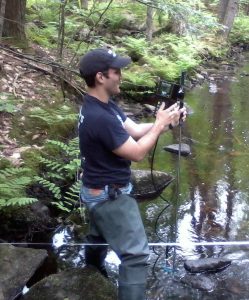Student Research Spotlight: Looking for Warning Signs Beneath the Surface
 The Sebago Lake watershed supplies water to 15 percent of Maine’s population, but projections indicate continued development over the next few decades could have a negative effect on water quality.
The Sebago Lake watershed supplies water to 15 percent of Maine’s population, but projections indicate continued development over the next few decades could have a negative effect on water quality.
Brett Gerard, a PhD student in the School of Earth and Climate Sciences, decided to look where early signs of change within the watershed might be detected: below the surface.
Working with the Senator George J. Mitchell Center for Sustainability Solutions, Gerard’s research examines the characteristics and dynamics of channel beds in the Sebago Lake watershed. The condition of sediment on the channel beds, Gerard explains, is one of the primary factors controlling the exchange of water between the river environment and the groundwater system. The exchange plays an important role in maintaining water quality.
“ I am particularly interested in the role of climate and human activities on channel bottom conditions” said Gerard who works on the Safeguarding a Vulnerable Watershed project. “I believe it might be an excellent location to detect changes from urban expansion. And changes to channel beds and the dynamics of river/groundwater exchange might be an indicator of future degradation in in water quality.” See more…
